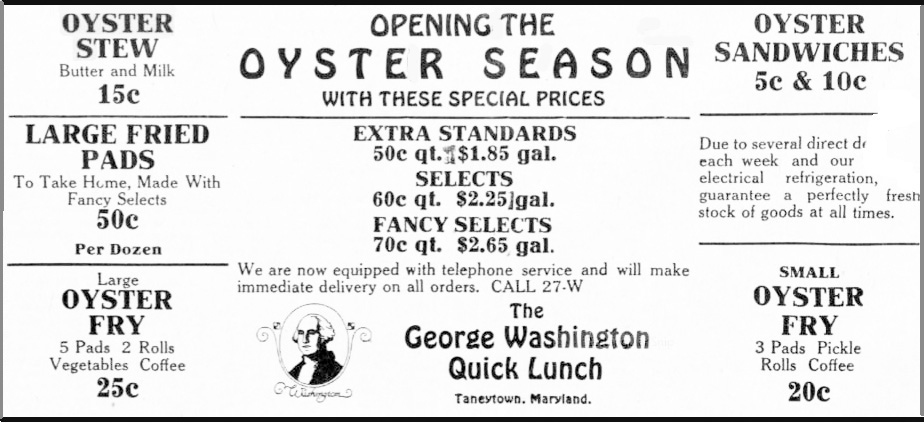Carroll Yesteryears
8 November 2020
Enjoying Oysters Has a Long History in Carroll
By Mary Ann Ashcraft
Oyster lovers in Maryland rejoiced when “R” months like November rolled around, even in the mid-19th century in locations miles far from the Chesapeake Bay like Carroll County.
Who would have guessed that oysters and ice cream were equally capable of attracting visitors 155 years ago, but such was the case at a Westminster fundraising fair in the autumn of 1865. Attendees were promised “Confectionery of every variety, Ice Cream, Oysters, and eatables constantly to be had.” These undoubtedly were fresh oysters just as the ones advertised a year later at Bish & Lupton’s West End Grocery in Westminster along with kraut, pickles, catsup, mincemeat, molasses, and other items. Lucky for the local shopper that a live oyster was pretty easy to distinguish from a dead one if it hadn’t been shucked!
Baltimore became the center of a thriving canning industry as early as the 1840s, including the canning of oysters. By 1870 there were more than 100 oyster packing houses in the city. Carroll County businessman and inventor Andrew K. Shriver patented a device called a steam retort in 1874 to preserve oysters and other foodstuffs in sealed cans, thus enabling their shipment anywhere by the canning firm he owned with Mark O. Shriver and Thomas J. Myer. If wealthy families wanted oysters for an elegant summer dinner party, perhaps they purchased cans from Thos. J. Myer & Co. Readers may want to explore more about packing and canning in a book by Jane Sears called “Baltimore’s Packing & Canning Industry: Directory of Individuals & Companies Engaged in the Oyster, Fruit & Vegetable Industry from 1840 to 1940.”
In 1870, H.B. Grammer placed an ad in Westminster’s Democratic Advocate for his “Ladies’ and Gentlemen’s Oyster Saloon” where he promised to serve guests “nicely cooked oysters” in the winter months. But if you preferred to serve oysters at home, Cyrus Stonesifer carried them in season at his Westminster store either fresh, spiced, or pickled along with canned fruits and other edibles.
Suppers featuring oysters became a staple in the county beginning in the latter part of the 19th century. Westminster’s Odd Fellows Hall was the site of one to benefit the Baptist Church in 1875, and in 1885 Grace Lutheran Church held an oyster supper “commencing on Thanksgiving evening and continuing for three evenings.”
As the years passed, Maryland’s State Department of Health began inspections to guarantee safe handling of oysters. An article in The Carroll Record of 1933 offered readers some insights.
“Certificates granted by the State Department of Health to oyster handling concerns now expire at the close of each season. They are renewable only after inspection by representatives of the Bureau of Food and Drugs of the State Department of Health has shown that State and Federal regulations have been complied with.
“In preparation for the season of 1933-1934, proprietors of oyster handling concerns throughout the State were reminded during the summer of requirements which must be met for shucked and canned oysters, in order that the product may be accepted for sale or for shipment, within or without the State.
“In the notices sent to oyster handlers, Mr. A.L. Sullivan, Chief of the Bureau of Food and Drugs, emphasized the care that should be given to structural requirements, with particular reference to sound flooring, adequate light and air space, benches and other equipment. Attention was directed to the need for sanitary dip cans, for provision for handwashing, for adequate supplies of soap and towels, handwashing signs, properly cared for hose, paddles, skimmers and for adequate provision for sterilization of containers and equipment and for storage of equipment. The oyster handlers were also notified that medical examination of shuckers should be made before they are taken on; and that unless otherwise advised, certificates would be accepted from physicians employed last year.”
Health Department officials expected over 200 packing plants would apply for certificates that year; how many plants could pass the inspection remained to be seen. This was the height of the Great Depression and everyone from oyster fishermen to shuckers needed jobs.
Turkey and oyster suppers still draw diners in Carroll County. Enthusiasts need only watch for newspaper advertisements such as a fund-raiser in 1952 by Taneytown High School’s P.T.A. It featured a mouth-watering menu: fruit cup, oysters, turkey, dressing, gravy, mashed potatoes, peas, Yankee potpie, sauerkraut, relishes, cupcakes, and coffee. If you were not satisfied, more food was sold separately!
The Chesapeake Bay no longer yields the tremendous quantity of oysters it once did and current prices reflect that. A quick internet check showed one Baltimore restaurant charged $2.00 per oyster on the half-shell. A plate of 5 oven-baked Skinny Dipper oysters, topped with cheese, butter, and Old Bay “roasted to perfection” cost $15.00. Another restaurant offered Oysters Rockefeller – a half dozen – for $14.00, but many places didn’t publish prices online.
While COVID-19 will likely cancel this year’s oyster suppers, you can satisfy your yearning for this Maryland delicacy by adding oysters to the stuffing of your Thanksgiving turkey.
Mary Ann Ashcraft is a volunteer at the Historical Society of Carroll County.
Courtesy photo – This 1933 restaurant ad from Taneytown’s newspaper, The Carroll Record, reflects the price of oysters in the midst of the Great Depression.






